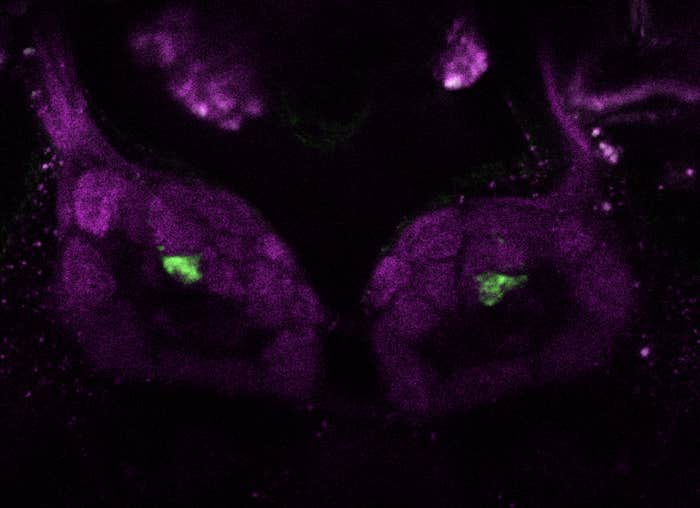For the first time, researchers have discovered that birds can sleep in flight. Together with an international team of colleagues, Niels Rattenborg from the Max Planck Institute for Ornithology in Seewiesen measured the brain activity of frigatebirds and found that they sleep in flight with either one cerebral hemisphere at a time or both hemispheres simultaneously. Despite being able to engage in all types of sleep in flight, the birds slept less than an hour a day, a mere fraction of the time spent sleeping on land. How frigatebirds are able to perform adaptively on such little sleep remains a mystery.
It is known that some swifts, songbirds, sandpipers, and seabirds fly non-stop for several days, weeks, or months as they traverse the globe. Given the adverse effect sleep loss has on performance, it is commonly assumed that these birds must fulfill their daily need for sleep on the wing.
Half-awake or fully awake in flight?
How might a bird sleep in flight without colliding with obstacles or falling from the sky? One solution would be to only switch off half of the brain at a time, as Rattenborg showed in mallard ducks sleeping in a dangerous situation on land. When sleeping at the edge of a group, mallards keep one cerebral hemisphere awake and the corresponding eye open and directed away from the other birds, toward a potential threat. Based on these findings and the fact that dolphins can swim while sleeping unihemispherically, it is commonly assumed that birds also rely on this sort of autopilot to navigate and maintain aerodynamic control during flight.
However, it is also possible that birds evolved a way to cheat on sleep. The sleep researcher’s and colleagues’ recent discovery that male pectoral sandpipers competing for females can perform adaptively for several weeks despite sleeping very little raised the possibility that birds simply forgo sleep altogether in flight. Consequently, evidence of continuous flight is not by default evidence of sleep in flight: Without directly measuring a bird’s brain state, previous claims that birds sleep in flight remain mere speculation.
Flight data recorder catches birds napping on the wing
To actually determine whether and how birds sleep in flight, the researchers needed to record the changes in brain activity and behavior that distinguish wakefulness from the two types of sleep found in birds: slow wave sleep (SWS) and rapid eye movement (REM) sleep. Niels Rattenborg teamed up with Alexei Vyssotski (University of Zurich and Swiss Federal Institute of Technology, ETH) who developed a small device to measure electroencephalographic changes in brain activity and head movements in flying birds.
On average frigatebirds slept only 42 minutes per day.
In collaboration with the Galápagos National Park and Sebastian Cruz, an Ecuadorian seabird biologist, the team focused on great frigatebirds nesting on the Galápagos Island. Frigatebirds are large seabirds that spend weeks flying non-stop over the ocean in search of flying fish and squid driven to the surface by predatory fish and cetaceans. The researchers temporarily attached the small “flight data recorder” to the head of nesting female frigatebirds. The birds then carried the recorder during non-stop foraging flights lasting up to 10 days and 3,000 kilometers. During this time, the recorder registered the EEG activity of both brain hemispheres and movements of the head, while a GPS device on the birds’ back tracked their position and altitude. After the birds were back on land and had had some time to recover, they were re-caught and the equipment was removed. Bryson Voirin, a post-doc and co-first author on the paper with Rattenborg observed that, “Like many other animals in the Galápagos Islands, the frigatebirds were remarkably calm and would even sleep as I approached to catch them for the second time.”
The flight data recorder revealed that frigatebirds sleep in both expected and unexpected ways during flight. During the day the birds stayed awake actively searching for foraging opportunities. As the sun set, the awake EEG pattern switched to a SWS pattern for periods lasting up to several minutes while the birds were soaring. Surprisingly, SWS could occur in one hemisphere at a time or both hemispheres together. The presence of such bihemispheric sleep indicates that unihemispheric sleep is not required to maintain aerodynamic control. Nonetheless, when compared to sleep on land, SWS was more often unihemispheric in flight. By carefully examining the movements of the frigatebirds, the researchers discovered clues to why they sleep unihemispherically in flight. When the birds circled on rising air currents the hemisphere connected to the eye facing the direction of the turn was typically awake while the other was asleep, suggesting that the birds were watching where they were going. “The frigatebirds may be keeping an eye out for other birds to prevent collisions much like ducks keep an eye out for predators,” says Rattenborg.
In addition to engaging in both types of SWS in flight, on rare occasions, bouts of SWS were interrupted by brief episodes of REM sleep. Although this finding may seem remarkable to scientists who study sleep in mammals, based on Rattenborg’s experience with birds, he was not that surprised. In contrast to mammals, wherein episodes of REM sleep are long and accompanied by a complete loss of muscle tone, REM sleep episodes only last several seconds in birds. In addition, although a reduction in muscle tone can cause the head to drop during avian REM sleep, birds are able to stand (even on one leg) during this state. Similarly, when frigatebirds entered REM sleep their head dropped momentarily, but their flight pattern remained unchanged.
Ecological demands require full attention 24/7 at sea
Perhaps the greatest surprise was that despite being able to engage in all types of sleep on the wing, on average frigatebirds slept only 42 minutes per day. In contrast, when back on land they slept for over 12 hours per day. In addition, episodes of sleep were longer and deeper on land. Collectively, this suggests that frigatebirds are actually sleep deprived in flight. “Why they sleep so little in flight, even at night when they rarely forage, remains unclear,” says Rattenborg. As previous studies have shown that frigatebirds follow ocean eddies predictive of good foraging conditions throughout the day and night, perhaps this is what they are up to. Interestingly, the low amount of sleep in flight suggests that this task requires more attention than that afforded by sleeping with one half of the brain at a time. As such, frigatebirds face ecological demands for full attention 24/7 while at sea.
In the long term, Rattenborg hopes to determine how frigatebirds are able to sustain adaptive performance on such little sleep. People will fall asleep driving a car after losing just a few hours of sleep, even when fully aware of the dangers and struggling to keep themselves awake. “Why we, and many other animals, suffer dramatically from sleep loss whereas some birds are able to perform adaptively on far less sleep remains a mystery,” notes Rattenborg. Reconciling the findings from frigatebirds with the wealth of evidence underscoring the importance of sleep in other animals may provide new perspectives on our understanding of sleep and the consequences of its loss.
This article was originally published by Max Planck Neuroscience on Aug. 3, 2016. The relevant study can be retrieved here.
Read more at Max Planck Neuro.





























